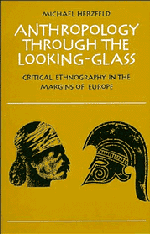Book contents
- Frontmatter
- Contents
- Preface
- Key to symbols
- 1 Romanticism and Hellenism: burdens of otherness
- 2 A secular cosmology
- 3 Aboriginal Europeans
- 4 Difference as identity
- 5 The double-headed eagle: self-knowledge and self-display
- 6 Strict definitions and bad habits
- 7 The practice of relativity
- 8 Etymologies of a discipline
- Notes
- Bibliography
- Index
5 - The double-headed eagle: self-knowledge and self-display
Published online by Cambridge University Press: 11 March 2010
- Frontmatter
- Contents
- Preface
- Key to symbols
- 1 Romanticism and Hellenism: burdens of otherness
- 2 A secular cosmology
- 3 Aboriginal Europeans
- 4 Difference as identity
- 5 The double-headed eagle: self-knowledge and self-display
- 6 Strict definitions and bad habits
- 7 The practice of relativity
- 8 Etymologies of a discipline
- Notes
- Bibliography
- Index
Summary
The clothing of identity: regulation against intimacy
The rise of an explicit ideology of European identity could not but exercise a strong influence on Greece, a nation-state conceived in relation to the idea of European culture and treated as an inferior variant by its politically stronger champions. Under conditions of such ambivalence, the double headed eagle of Byzantium aptly became one of the symbols shared by the folk tradition and the official ideology. The symbolic opposition between European and oriental brought into play a series of further contrasts, which at first seem amenable to the formal structuralist device of the two-column diagram.
This device acquired a certain popularity in the 1960s, mostly amongst Oxford structuralists. In its bare essentials, it is a paired list of symbolic oppositions (left/right, black/white, sin/blessing, female/male etc.), arranged in such a way as to suggest that each opposition “stood for” all the others in a transformational series (see especially Needham 1973). One such diagram did in fact appear in a major ethnography of a Greek community, as a means of ordering the values associated with male and female stereotypes (Christ/Devil, wisdom/gullibility, and so on [du Boulay 1974:104]). But this soon paled into unobtrusive modesty beside a two column proclamation of “the Mediterranean code of honour” (Blok 1981:430–1; my italics).
As a device of ethnographic representation, such diagrams are undoubtedly both useful and dangerous: useful inasmuch as they summarize the stereotypes at a glance, dangerous in that they very easily become an excuse for ignoring the uses that people make of stereotypical attributes.
- Type
- Chapter
- Information
- Anthropology through the Looking-GlassCritical Ethnography in the Margins of Europe, pp. 95 - 122Publisher: Cambridge University PressPrint publication year: 1988



